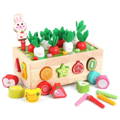The Evolution of Montessori Toys: A Historical Perspective
Many agree that toys are more than just fun. Montessori toys, for example, play an important role in helping children develop problem-solving, motor skills, and overall cognitive development.
But have you ever wondered where these toys came from? How did Montessori toys adapt to meet children’s needs through the ages?

Montessori toys are actually educational toys. However, the whole concept of these toys was different in the beginning. Children were given only a couple of toys to play with, which we can’t even compare with today’s standards.
Now, kids have plenty of options, but not all are educational. So, let’s examine how Montessori toys became popular throughout the years.
History of Montessori and Educational Toys
Toys have been around since Ancient Greece, but the 17th century marked a turning point when philosopher John Locke talked about educational toys. His idea was that alphabet blocks could make learning more fun for kids. John began experimenting with this idea, and it turned out to be true - children loved playing with blocks that had pictures, numbers, and letters on them.
One century passed, and another educator, Friedrich Wilhelm August Froebel, made special wooden toys. These toys were actually geometric objects that children loved playing with.
Fast-forward to the 19th century, an Italian educator, Maria Montessori, took things up a notch. She introduced colorful wooden toys with different shapes and finishes, calling them sensorial materials.
These toys would help children develop cognitive abilities and practice motor skills. They were designed to let kids correct themselves while playing, promoting independence and problem-solving.

As we jump to the 20th century, the boom in educational toys took a slightly different turn. Namely, with the evolution of technology, educational toys accepted the concept of tech trends. Fortunately, it’s not only about technology, as educational toys are still focusing on children’s development.
With a focus on children's health and education, you can choose many toys right now. Most importantly, these toys hold their value in terms of education and the overall benefits that they provide for our little ones.
What is the Philosophy of Montessori Toys?
The core philosophy behind Montessori toys is to stimulate learning by encouraging kids to experiment and explore. These toys are made to push children to do more, not just play to have fun.

Therefore, one of the key features of Montessori toys is that they are created to spark imagination and creativity. Every minute your child spends exploring a Montessori toy’s features, they are actually learning quite a lot.
Also, learning to manipulate objects is crucial for helping children develop their motor skills and problem-solving abilities. And that’s exactly how your child would play with these toys.
So, the philosophy of Montessori toys is all about hands-on exploration, sparking curiosity, and helping kids develop in the right direction.
What Are Montessori Toys Made Of?
Montessori toys are made from natural materials like wood, wicker, cotton, metal, and sometimes even plastic. They follow a simple idea: "It's all about keeping it real with everyday materials."

They come from a philosophy of simplicity and exploration. So, they’re not about being fancy or eye-catching; they’re about providing materials for children to learn as they play.
Wooden blocks, cotton-based puzzles, and metal or glass elements create a sensory experience for children. These materials are carefully selected to stimulate and connect your child's senses with the real world.
On top of that, natural textures, shapes and colors, and even the weight of these toys provide a multisensory experience. All these features create a deep connection between the child and the learning process.
Montessori Toys Today - Making Learning Fun
Did you know that the brain reaches approximately 80% of its adult size just before the person turns two? Interesting fact, indeed.
And, at this age, children are most active; they soak like little sponges. So, it’s important to enable them to use that energy to learn and develop in the right direction. And what better way to use Montessori toys than this?

Here are a couple of benefits of Montessori toys:
- Sensory stimulation: These toys use colors, textures, and sounds, making playtime super fun and helping kids learn more about the world around them.
- Promotion of independence: Montessori toys are great for playing alone, which helps kids learn to do things by themselves and feel confident.
- Introduction to complex concepts: These toys often introduce complex concepts in a simple and hands-on manner, solving a wooden puzzle, for example.
- Logical learning in order: Montessori toys are like building blocks; you start with simple things and go on to more exciting stuff. It's learning one step at a time.
However, the benefits of Montessori toys can vary significantly depending on the toy chosen and how it’s introduced to a child. Overall, all Montessori toys are specially designed to promote learning through play.
Let’s take a look and see some of the most popular options today.
Montessori Double-Sided Puzzles - Double the Excitement

Imagine five puzzles with ten designs - all in one pack! The Montessori Double-Sided Puzzles make learning fun, especially for kids who love experimenting with shapes and colors. Putting the pieces in the right spots is like a mini-challenge and the reward factor afterward.
Also, with this toy, your little one will learn how to solve puzzles and come up with their own solutions and ideas. They will get better at grabbing things and using their eyes and hands together.
Here are some noticeable benefits of Montessori double-sided puzzles:
- Stress relief: This puzzle helps calm down those little bundles of energy as they require focus and commitment.
- Extended fun time: It’s not easy to solve a puzzle, especially for kids who have never tried it before. So, these puzzles will extend the playtime for quite some time.
- Make your kid independent: They boost focus and independence, making children do things on their own.
All in all, these puzzles are perfect for toddlers, as they’ll love manipulating objects and stacking them the right way.
Montessori Carrot Wheels - Make Fruits and Veggies Exciting

Is it possible for kids to learn about veggies and fruits just from playing with one toy? You bet! Montessori Carrot Wheels is a toy that perfectly showcases one crucial aspect of the Montessori philosophy - getting the most out of the least.
Your little one can learn shape sorting, get excited about fruits and veggies, discover basic physics and magnetism, and even enjoy some physical activity by pushing the cart.
Here are some benefits:
- Fine and gross motor skills: Playing with this toy helps your little one get better at using both small and big muscles.
- Problem-solving: This toy teaches your child to solve problems and think logically while having a blast.
- Focus and attention: Watch as your toddler stays focused and engaged, developing a longer attention span.
Another great benefit of this toy is that it offers active playtime without screens. This means your child will use their imagination and creativity instead of looking at your phone.
Conclusion:
Montessori toys have come a long way, starting from simple blocks to advanced, hands-on tools our children use for learning today. Thanks to Maria Montessori, these toys help kids learn and have fun at the same time.
Now, in the 21st century, these types of toys are still popular. One could say that the simplicity behind these toys is making them evergreen. So, no matter if it's a cool wooden puzzle or a fruit and veggie set, Montessori toys make your kids learn and develop.
In that light, get one for your kid too! One thing is certain: they’ll love it!
Free Delivery
Over $80
Easy Returns
No questions asked
Unbeatable Warranty
1-year ++ warranty
- Secure CheckoutWorld’s most secure payment method




